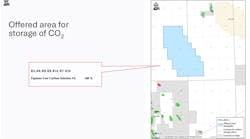Geoscience at OTC
The Offshore Technology Conference is the industry’s largest gathering of expertise and tools devoted to the location, development, and extraction of hydrocarbons from the depths of the world’s ocean. For some, the most exciting part of each gathering is the advance of the industry’s operating envelope into ever-deeper waters. Stepping-out into deeper water expands the economic frontier for exploration and development.
Imaging and quantifying the deepwater potential ahead of the drillers is the role of the geosciences. At present the ability to produce in the expanding operational envelope is the main constraint. The ability to drill in deeper water exceeds the ability to produce in the new frontier, and the ability to image in the expanding envelope is ahead of both of these trailing operations.
Identifying deepwater prospects and characterizing the reservoirs continues to be a challenge and is one reason that the Society of Exploration Geophysicists and American Association of Petroleum Geologists are involved as two of the 12 professional organizations that sponsor and present papers at OTC. Of the 49 sessions planned over four days, 10 sessions deal with the geosciences. The SEG is sponsoring five sessions and AAPG is sponsoring five sessions. There is one panel session.
According to Craig Shipp, AAPG/OTC subcommittee vice-chair, there are interesting papers each day of the conference. On Monday, May 2, two sessions on “Petrotechnical Visualization” provide a full day of papers on the utility of 3D visualization to solve reservoir and infrastructure problems. In the afternoon, the session “Attributes of Success…” focuses on the ability of seismic interpretation to define and characterize reservoirs.
The choices expand on Tuesday morning, May 3, beginning with a panel on “Digital Energy-Case Studies….” This session explores the growing use of digital monitoring and the value it brings to deepwater operations. At the same time a session on “Controlled Source Electromagmetics” examines this new technology and the way it is augmenting traditional seismic prospecting. A session on “Quantifying Risk and Uncertainty in Geohazards…” runs concurrently and highlights advances in well-siting.
Tuesday afternoon offers a session on “Gas Hydrates…” and their hazard potential. Of special interest is a paper on using electromagnetic surveying to define the potential hydrate hazard.
On Wednesday morning, May 4, geotypes get a break to view the show floor, but the pace quickens again in the afternoon. The session “Advances in Borehole Sonic Logging…” explores the expanding use of this venerable technology for anisotropy determination and reservoir monitoring. Also in the afternoon “Geohazards of Field Developments” presents case studies from around the world.
The final geo-session is on Thursday morning, May 5. “Ivan the Terrible” explores the multifaceted effects of this hurricane and the damage it produced on the Gulf of Mexico’s seafloor and oil infrastructure.
Every OTC geo-session is rich in case studies for application to your field problems.
Technology
New processing center
CGG opened a new data processing center in Mumbai, India, running Geocluster processing software.
“The opening of this new center in Mumbai marks a new stage in our strategy to strengthen our position in India as a provider of the full range of seismic services. Historically, CGG has been a constant contributor to India’s exploration efforts for the last 40 years and this move further underlines our commitment to support India in fast-tracking its E&P efforts,” said Robert Brunck, chairman and CEO of CGG.
Software addition
Halliburton Digital and Consulting Solutions acquired the smartSection geologic software business from A2D Technologies adding the raster image cross-section application with depth-calibrated well log images for high volume well log correlation and geologic interpretation. “We plan to work very closely with A2D to continue to support and enhance the delivery of A2D’s well log data, as well as enable smartSection software to import a broad range of commercially available raster images and depth registrations. We also have plans to integrate smartSection software with the GeoGraphix database and Landmark’s OpenWorks database,” said Jonathan Lewis, vice president, Innovation and Marketing, Halliburton Digital and Consulting Solutions.
Hydrographic advance
iXSea launched Hydrins a real-time solution for hydrographic surveyors. The navigation system interfaces with a multibeam sounder to provide real-time, bathymetric data. This algorithm computes position (less than 1 m in 1 min) during GPS downtime, an important feature when GPS drop out occurs.
EXPLORATION
Sri Lanka survey
TGS-Nopec Geophysical Co. and Fugro Geoteam are collecting a multi-client 2D survey off Sri Lanka, South Asia. The 4,750 km SL05 survey will extend data acquired by the TGS’s earlier SL01 survey. Data is being acquired over part of the Mannar basin, which was largely unknown before TGS’ work in the area in 2001.
GoM survey
TGS-Nopec is expanding its Deep Resolve survey in the Gulf of Mexico. The multi-client 3D seismic survey is being gathered in the deep gas exploration trend. The project is now double the original size and covers an area equal to 400 OCS blocks (8,400 sq km) in the Ship Shoal, South Timbalier, Grand Isle, and Ewing Bank areas offshore Louisiana. Acquisition will be completed in July 2005.
Falkland survey
Falkland Oil and Gas Ltd. completed 50% of the planned 10,500 km 2D seismic survey in its 83,000 sq km license area south and east of the Falkland Islands. TheGSI Admiral will shoot through April 2005. The processed survey and interpreted results will be available mid year.
Ireland survey
The Marine Institute of Ireland is conducting a hydrographic seabed survey program over the Irish shelf. Ireland’s national research vessels,Celtic Explorer and Celtic Voyager, are gathering the data.
Ireland’s territorial seabed reaches over 600 mi into the Atlantic Ocean to over 4,500 m water depth. The Irish National Seabed Survey (INSS) will cover +450,000 sq km, the largest survey to date and includes new areas. Magnetic, subbottom profiler, and gravity data are being gathered to evaluate the deep geology.




